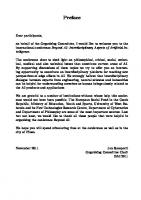Artificial Intelligence Ethics and International Law - 2nd Edition : Practical approaches to AI governance [2 ed.] 9788195993208, 9788195708789
Unveiling the future: Navigating AI's Intricate Intersection with International Law – A Journey Beyond Hype and Gov
128 32 9MB
English Pages 312 Year 2024
Table of contents :
Cover
Title Page
Copyright Page
Dedication Page
Foreword
Foreword
Testimonials
About the Author
About the Reviewer
Acknowledgement
Preface
Table of Contents
Section 1: Introduction
1. Artificial Intelligence and International Law
The complexity in understanding AI
Using legal linguistics to interpret disruptive technologies
Outlook beyond Law 1.0 and 2.0
Conclusion
References
Section 2: Technology Governance
2. Pragmatism in Governing AI
The Workflow of International Law
The Limitations of International Law
Sovereignty and International Cyber Law
Different shades of multilateral governance
Concept – Entity – Industry Classification Method
Subject – Object – Third Party Method
Analytics, automation, and intelligence in diplomacy
Conclusion
References
Endnotes
3. The Innovation and Economics of AI
Weaponization of data, algorithms, and everything
What is the weaponization of everything?
Artificial Intelligence hype is real
Conclusion
References
Section 3: Classification and Recognition of Artificial Intelligence
4. Legal Visibility
What is Legal Visibility?
Recognition of AI in Common Law Systems
The Tegmark Approach of AI Ethics
Realm of Dimensional Perpetuity
Digital Identity in AI and International Law
How Data Quality and Privacy Shapes AI Recognition
Entitative Nature of Artificial Intelligence
The Human-Artifact Conjunction
Conclusion
References
Endnotes
5. The Privacy Doctrine
The Linear Approach of Human Rights
Problems with reactionary approach to legal thinking
What is the Privacy Doctrine?
Interaction
Revelation
Relation
Beyond radicalism in International Human Rights Law
A Unique Approach to International Privacy Law
Sovereignty and Natural Morality in Industry 4.0
The Rule of Law Question on a Human Right in the Eyes of Law
From equality to manifested equity
Conclusion
References
Endnotes
6. The ISAIL Classifications of Artificial Intelligence
Recognizing the status of the algorithm
Concept-Entity-Industry Classification
Concept
Entity
Industry
Subject-Object-Third party classification
The doctrine of manifest availability
Conclusion
References
Section 4: Artificial Intelligence in a Multi-polar World
7. AGI and Digital Colonialism
The Multi-polar world: Explained
From Narrow AI to AGI
How Digital Colonialism shapes AI ethics norms
Ideology
Technology
Economics
Limits of Responsible AI
Artificial Intelligence Hype in Competition Law
Stage 1: Influence or generation determination
Stage 2: Influencing or generating market perceptions and conditions
Stage 3: Uninformed or disinformed markets
Stage 4: Misdirected perceptions in the information and digital economy
Stage 5: Estimation of the Hype Cycle through risk determination
Conclusion
References
8. Self-Regulating the Future of AI
Generative AI and Derivation of AI-based products and services
General Intelligence applications
Standalone Generative AI applications
Derivative Generative AI Applications
How to enable responsible and economic innovations
India’s role in shaping global technology norms
Soft Law Recommendations on the future of AI
Conclusion
References
Index
Cover
Title Page
Copyright Page
Dedication Page
Foreword
Foreword
Testimonials
About the Author
About the Reviewer
Acknowledgement
Preface
Table of Contents
Section 1: Introduction
1. Artificial Intelligence and International Law
The complexity in understanding AI
Using legal linguistics to interpret disruptive technologies
Outlook beyond Law 1.0 and 2.0
Conclusion
References
Section 2: Technology Governance
2. Pragmatism in Governing AI
The Workflow of International Law
The Limitations of International Law
Sovereignty and International Cyber Law
Different shades of multilateral governance
Concept – Entity – Industry Classification Method
Subject – Object – Third Party Method
Analytics, automation, and intelligence in diplomacy
Conclusion
References
Endnotes
3. The Innovation and Economics of AI
Weaponization of data, algorithms, and everything
What is the weaponization of everything?
Artificial Intelligence hype is real
Conclusion
References
Section 3: Classification and Recognition of Artificial Intelligence
4. Legal Visibility
What is Legal Visibility?
Recognition of AI in Common Law Systems
The Tegmark Approach of AI Ethics
Realm of Dimensional Perpetuity
Digital Identity in AI and International Law
How Data Quality and Privacy Shapes AI Recognition
Entitative Nature of Artificial Intelligence
The Human-Artifact Conjunction
Conclusion
References
Endnotes
5. The Privacy Doctrine
The Linear Approach of Human Rights
Problems with reactionary approach to legal thinking
What is the Privacy Doctrine?
Interaction
Revelation
Relation
Beyond radicalism in International Human Rights Law
A Unique Approach to International Privacy Law
Sovereignty and Natural Morality in Industry 4.0
The Rule of Law Question on a Human Right in the Eyes of Law
From equality to manifested equity
Conclusion
References
Endnotes
6. The ISAIL Classifications of Artificial Intelligence
Recognizing the status of the algorithm
Concept-Entity-Industry Classification
Concept
Entity
Industry
Subject-Object-Third party classification
The doctrine of manifest availability
Conclusion
References
Section 4: Artificial Intelligence in a Multi-polar World
7. AGI and Digital Colonialism
The Multi-polar world: Explained
From Narrow AI to AGI
How Digital Colonialism shapes AI ethics norms
Ideology
Technology
Economics
Limits of Responsible AI
Artificial Intelligence Hype in Competition Law
Stage 1: Influence or generation determination
Stage 2: Influencing or generating market perceptions and conditions
Stage 3: Uninformed or disinformed markets
Stage 4: Misdirected perceptions in the information and digital economy
Stage 5: Estimation of the Hype Cycle through risk determination
Conclusion
References
8. Self-Regulating the Future of AI
Generative AI and Derivation of AI-based products and services
General Intelligence applications
Standalone Generative AI applications
Derivative Generative AI Applications
How to enable responsible and economic innovations
India’s role in shaping global technology norms
Soft Law Recommendations on the future of AI
Conclusion
References
Index
![Artificial Intelligence Ethics and International Law - 2nd Edition : Practical approaches to AI governance [2 ed.]
9788195993208, 9788195708789](https://ebin.pub/img/200x200/artificial-intelligence-ethics-and-international-law-2nd-edition-practical-approaches-to-ai-governance-2nbsped-9788195993208-9788195708789.jpg)

![Artificial Intelligence Governance and the Blockchain Revolution (Artificial Intelligence and the Rule of Law) [2024 ed.]
9819992109, 9789819992102](https://ebin.pub/img/200x200/artificial-intelligence-governance-and-the-blockchain-revolution-artificial-intelligence-and-the-rule-of-law-2024nbsped-9819992109-9789819992102-d-1854394.jpg)
![Artificial Intelligence Governance and the Blockchain Revolution (Artificial Intelligence and the Rule of Law) [2024 ed.]
9819992109, 9789819992102](https://ebin.pub/img/200x200/artificial-intelligence-governance-and-the-blockchain-revolution-artificial-intelligence-and-the-rule-of-law-2024nbsped-9819992109-9789819992102.jpg)



![The practitioner's guide to international law [2nd edition.]
9780409340228, 0409340227](https://ebin.pub/img/200x200/the-practitioners-guide-to-international-law-2nd-edition-9780409340228-0409340227.jpg)


